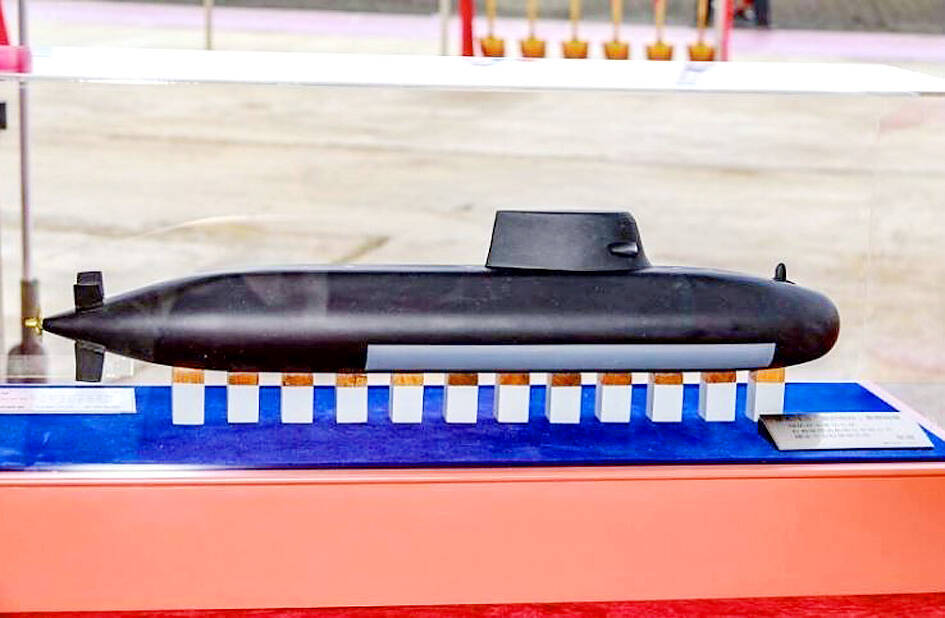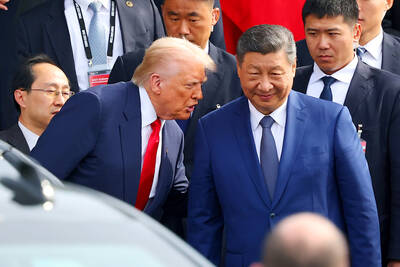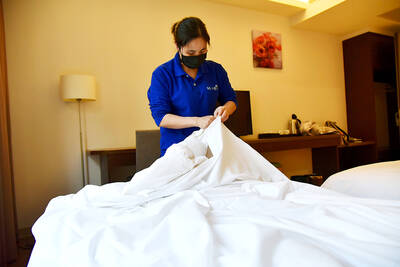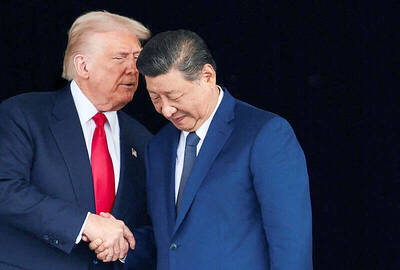Taiwan hopes to deploy at least two new, domestically developed submarines by 2027, and possibly equip later models with missiles to bolster its deterrence against the Chinese navy and protect key supply lines, the head of the program said.
Taiwan has made the Indigenous Submarine Program a key part of an ambitious project to modernize its armed forces as Beijing stages almost daily military exercises.
President Tsai Ing-wen (蔡英文), who initiated the program when she took office in 2016, is expected to launch the first of eight new submarines on Thursday under a plan that has drawn on expertise and technology from several nations — a breakthrough for diplomatically isolated Taiwan.

Photo courtesy of the Ministry of National Defense
Admiral Huang Shu-kuang (黃曙光), head of the nation’s Indigenous Defense Submarine program, said that a fleet of 10 submarines — which includes two Dutch-made submarines commissioned in the 1980s — would make it harder for the Chinese navy to project its power into the Pacific.
“If we can build up this combat capacity, I don’t think we will lose a war,” Huang this month told an internal briefing on the project, which was attended by Reuters.
Huang said the first submarine, with a price tag of NT$49.36 billion (US$1.54 billion), would use a combat system by Lockheed Martin Corp and carry US-made MK-48 heavyweight torpedoes. It is to enter sea trials next month before being delivered to the navy by the end of next year.
For subsequent models, Taiwan would leave space for submarine-launched anti-ship missiles, but adding those weapons depends on production availability in the US, where capacity is already tight, Huang said, without naming the companies that would be involved.
He called the submarines a “strategic deterrent” to Chinese warships crossing the Miyako Strait near southwestern Japan or the Bashi Channel that separates Taiwan from the Philippines.
Taiwan’s diesel-electric submarines can keep China at bay within the first island chain, Huang said, referring to the area that runs from Japan through Taiwan, the Philippines and on to Borneo, enclosing China’s coastal seas.
“This was also the strategic concept of the US military — to contain them within the first island chain and deny their access,” he said. “If Taiwan is taken, Japan will definitely not be safe, South Korea will definitely not be safe.”
The Chinese Ministry of National Defense did not respond to a request for comment.
The Chinese navy, including its Shandong aircraft carrier, has become increasingly active in the past few months off Taiwan’s eastern coast, prompting worries that Beijing could launch an attack from that direction. Eastern Taiwan is where planners have long envisioned the military regrouping and preserving its forces during a conflict.
The submarines can help maintain Taiwan’s “lifeline” to the Pacific by keeping ports along its eastern coast open for supplies in a conflict, Huang said.
“The submarines will keep their ships away from our eastern shores,” he said.
Chieh Chung (揭仲), a military researcher at the National Policy Foundation think tank, said the fleet would have trouble with that task, because China could position warships in the Pacific before launching an attack.
However, he added that the submarines could occupy strategic ambush points in the region and “greatly harm [China’s] combat ability” by targeting high-value ships such as carrier groups or landing fleets.
Taiwan has quietly sourced technology, components and talent from at least seven nations to help it build submarines, a Reuters investigation has found.
Getting foreign assistance was particularly challenging for Taiwan, which does not have official ties with most nations.
Huang declined to say which nations had approved export permits, but said he had reached out to generals from nations that included the US, Japan, South Korea and India.
“For those foreign generals who agreed with my ideas, they helped convey the message to their governments or arrange meetings,” he said. “I told them our needs and that’s how we achieved our purpose of securing export permits.”
Huang also expressed thanks for “great help” from a team led by an unnamed retired rear admiral of Britain’s Royal Navy, who secured export permits from the UK through a Gibraltar-based company.
Britain sharply increased the amount of submarine parts and technology exports approved for Taiwan last year, a Reuters analysis of the data showed.
Huang described the program as “even harder than reaching the sky,” citing challenges such as a global chip shortage that hit many manufacturers around the world.
He said his team scrambled to source chips from Taiwan to avoid delays by foreign vendors.
A foreign supplier had also pulled out at the last minute after the work with Taiwan was leaked to a Chinese embassy, he said, without elaborating.
China’s frequent military harassment, including close approaches to Taiwan’s territorial waters and airspace, has prompted Taiwan and the US to rethink the nation’s “asymmetrical” strategy of making its forces more mobile and harder to attack, with a focus on smaller weapons systems, he said.
“The American thinking is changing gradually. They realized that you can’t withstand [the harassment] without bigger boats,” Huang said, pointing to the navy’s plan to build a new generation of bigger frigates.
“They are getting closer and closer,” he said, referring to China.

CALL FOR SUPPORT: President William Lai called on lawmakers across party lines to ensure the livelihood of Taiwanese and that national security is protected President William Lai (賴清德) yesterday called for bipartisan support for Taiwan’s investment in self-defense capabilities at the christening and launch of two coast guard vessels at CSBC Corp, Taiwan’s (台灣國際造船) shipyard in Kaohsiung. The Taipei (台北) is the fourth and final ship of the Chiayi-class offshore patrol vessels, and the Siraya (西拉雅) is the Coast Guard Administration’s (CGA) first-ever ocean patrol vessel, the government said. The Taipei is the fourth and final ship of the Chiayi-class offshore patrol vessels with a displacement of about 4,000 tonnes, Lai said. This ship class was ordered as a result of former president Tsai Ing-wen’s (蔡英文) 2018

UKRAINE, NVIDIA: The US leader said the subject of Russia’s war had come up ‘very strongly,’ while Jenson Huang was hoping that the conversation was good Chinese President Xi Jinping (習近平) and US President Donald Trump had differing takes following their meeting in Busan, South Korea, yesterday. Xi said that the two sides should complete follow-up work as soon as possible to deliver tangible results that would provide “peace of mind” to China, the US and the rest of the world, while Trump hailed the “great success” of the talks. The two discussed trade, including a deal to reduce tariffs slapped on China for its role in the fentanyl trade, as well as cooperation in ending the war in Ukraine, among other issues, but they did not mention

HOTEL HIRING: An official said that hoteliers could begin hiring migrant workers next year, but must adhere to a rule requiring a NT$2,000 salary hike for Taiwanese The government is to allow the hospitality industry to recruit mid-level migrant workers for housekeeping and three other lines of work after the Executive Yuan yesterday approved a proposal by the Ministry of Labor. A shortage of workers at hotels and accommodation facilities was discussed at a meeting of the legislature’s Transportation Committee. A 2023 survey conducted by the Tourism Administration found that Taiwan’s lodging industry was short of about 6,600 housekeeping and cleaning workers, the agency said in a report to the committee. The shortage of workers in the industry is being studied, the report said. Hotel and Lodging Division Deputy Director Cheng

‘SECRETS’: While saying China would not attack during his presidency, Donald Trump declined to say how Washington would respond if Beijing were to take military action US President Donald Trump said that China would not take military action against Taiwan while he is president, as the Chinese leaders “know the consequences.” Trump made the statement during an interview on CBS’ 60 Minutes program that aired on Sunday, a few days after his meeting with Chinese President Xi Jinping (習近平) in South Korea. “He [Xi] has openly said, and his people have openly said at meetings, ‘we would never do anything while President Trump is president,’ because they know the consequences,” Trump said in the interview. However, he repeatedly declined to say exactly how Washington would respond in